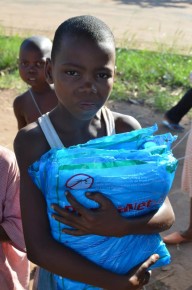
Last week I travelled to the province of Equateur in north-western Democratic Republic of Congo (DRC) to launch a bednet distribution programme that will protect 8 million people from malaria.
Equateur is the DRC's largest province - larger than Zimbabwe. Yet, it is marginalised by government and aid programmes alike. It is physically isolated, straddling the Congo river and covered in a maze of waterways and equatorial rainforest. It would be fair to say that it is probably one of the most remote and inaccessible places there is - at least where the Department for International Development (DFID) works.

And, it is perhaps one of the most challenging environments to embark on a programme to provide every person – for the first time – with a mosquito net to sleep under to protect them from catching and spreading malaria.
Malaria is the major killer of pregnant women and children under 5 in Equateur. It is largely responsible for the horrific under 5 mortality rate which means that 171 children in every 1,000 die before their 5th birthday (the rate for the UK is 5 per 1,000). That means that my 4 year old daughter would be 35 times more likely to die in Equateur than in the UK.
The reality of saving lives in challenging environments
I travelled to the provincial capital Mbandaka and then a further 2 hours up river (thanks to the expert flying of Aviation Sans Frontières) to Lisala to launch the distribution of 4.2 million mosquito nets that will save the lives of around 40,000 children. I spent 3 days visiting distribution points and seeing first-hand the practical realities of working in one of the country’s most challenging operating environments.
The pictures below give an idea of the logistical challenges DFID's implementing partner - Population Services International / Association de Santé Familiale (PSI/ASF) - face as they work out the best and most effective ways to get nets to every family in the province, through forests and across rivers.

I came home rocked by the reality of programming in this environment with more questions than answers. This project is relatively simple to explain: we buy nets, we communicate on how to use them, and the nets are distributed. Yet, in Equateur it could not be more challenging.
Later, putting my two small children (both under 5 years old) to bed, I notice holes forming in their nets after 18 months use. How long will the nets in Equateur really last in villages where people don't have electricity to see at night or wooden frames to hold the nets up? What do they do when there is nowhere to buy a replacement? What happens when these nets approach the end of their useable lives after two or three years, or if like my kids' nets they start to deteriorate?
I had previously advocated that we need to move towards a ‘social marketing’ approach, one that provides nets at a subsidised price to allow an exit strategy for external financers. Elsewhere maybe, but here in Equateur even the smallest price may be too much at this point.

The DRC Government plans that Equateur will have another distribution of nets 3 years from now. But this is uncertain and will depend on sufficient funding being secured and all the usual delays purchasing and transporting nets. Is it really efficient to go through this whole process again?
Without follow-up people will stop using nets at night and malaria will increase again. Can we strengthen health services to ensure that there is routine follow-up that provides nets to protect the most vulnerable. But what happens when there are few - if any - health services?
These questions apply across our programmes and are a common threat which I will return to through these blogs. More immediately, I return to Kinshasa committed to ensuring that the investments in raising awareness and increasing the use of nets to combat malaria are maximised.
More widely, it is clear that we need to work with the DRC government and international and national partners to think about how we tackle the challenges of poverty in Equateur head on.

5 comments
Comment by Erin posted on
Hi Pete - I really enjoyed reading this entry. I work on a similar net distribution campaign. I'm curious how 4.2 million nets only translates to 40,000 children's lives. Are you doing one net per person, and there were only 40,000 children living in this area (of the 4.2 million)?
I share similar frustrations about the sustainability of this type of distribution and I hope the global community can come together to find a solution.
Comment by Rob Yates posted on
Excellent article Pete and congratulations on the bednet programme.
You are absolutely right in concluding that mass distributions of free nets are more efficient and equitable than social marketing schemes in settings such as Equateur. In fact this will be true for the whole of DRC. This has been proved conclusively by MIT's Povertry Action Lab using randomised controlled trials: http://www.povertyactionlab.org/evaluation/free-distribution-or-cost-sharing-evidence-malaria-prevention-experiment-kenya. Also what is true for bednets is also true for other preventive health commodities: http://www.povertyactionlab.org/policy-lessons/health/pricing-health-products.
Furthermore social marketing of nets wouldn't provide you with an exit strategy anyway. Given the low disposable income of the population you would still need to massively subsidise the nets if you wanted to reach the poor - and at any positive price some people would still be excluded. Furthermore one would have all the additional administrative costs to take into account - especially if you get into handing out vouchers and reimbursing suppliers.
So my advice for your programme in DRC is stick to mass free disrtibutions of health care commodities (what about family planning supplies too?) and encourage the Government to take on the responsibility for procurring and distributing these goods. This should prove a much more effective, efficient and equitable strategy
Kind regards
Rob Yates
Comment by Rebecca posted on
Just want to say - lived in Mbandaka for almost 2 years - so know just what a feat this can be. Overwhelming and fascinating-words hardly capture what it is like to be there!
Comment by Ivy posted on
Hi Pete, thank you for shearing this piece of information with the world.
I am a student and I am conducting ITNs distribution and parterns in the Su-Kivu provice of DRC. Do you have a vital statistics of Net distribution partners and number of household that received nets from your organization?
This will realy help my rsearch project.
Thanks.
Ivy
Comment by Charlie Cacici posted on
PETER
Please email me so we an connect. My partner and I were awarded 48 concessions totaling 33 million acres of rainforest in the Equateur Province of the DRC. Our responsibility is to preserve the rainforest, harvest and sell the associated carbon credits and implement social improvement projects; i.e planned communities, new agricultural processes, water purification processes, etc. I also have a friend who owns a clothing manufacturer and he created a clothing line to protect people from mosquitos and malaria. I believe there are common interests here. Please email me so we can connect. Thanks!